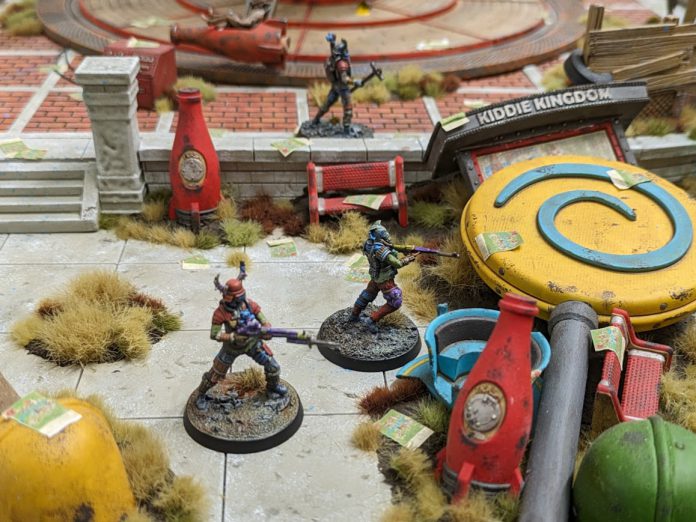Fallout is one of the biggest sci-fi franchises in the world, especially with a lavish TV series about to launch. But one area where it has had a slightly difficult life is in miniature games, where the intimidating Wasteland Warfare has ruled the roost until now. Wasteland Warfare has extremely passionate fans, but the granularity and toolbox nature of the system and releases has limited its wider appeal. The solution? Fallout: Factions, the next skirmish miniature game from Modiphius designed to be an easy entry into Fallout and miniature gaming. I got my hands on the game early at the launch event hosted in Nottingham on the 15th March, and a chance to speak with some of the people involved in its creation.
Thanks so much to Modiphius for inviting me along, and for putting on a great event.
First Experiences
When I arrived my first goal was of course to get some time with the game itself, and there were three lavish boards set up for demo games. All of them represented a different part of the Nuka-World theme park, the setting of the core box. It’s not a part of the setting that’s immediately familiar to me or, I think, to many other people, but after chatting with the staff there I began to understand it better. The different raider warbands available on launch (the Operators, the Pack and the Disciples) are all different enough to be easily visibly distinguishable, even in bare plastic, but none of them are so far out of the raider baseline that you’re being thrown into too much weirdness right out of the gate when you’re learning the game. There are Super Mutant and Brotherhood of Steel get-you-by lists out already, and it seems likely we’ll see fuller offerings for them very soon… but to learn the game, the raider factions in the core box are perfect.
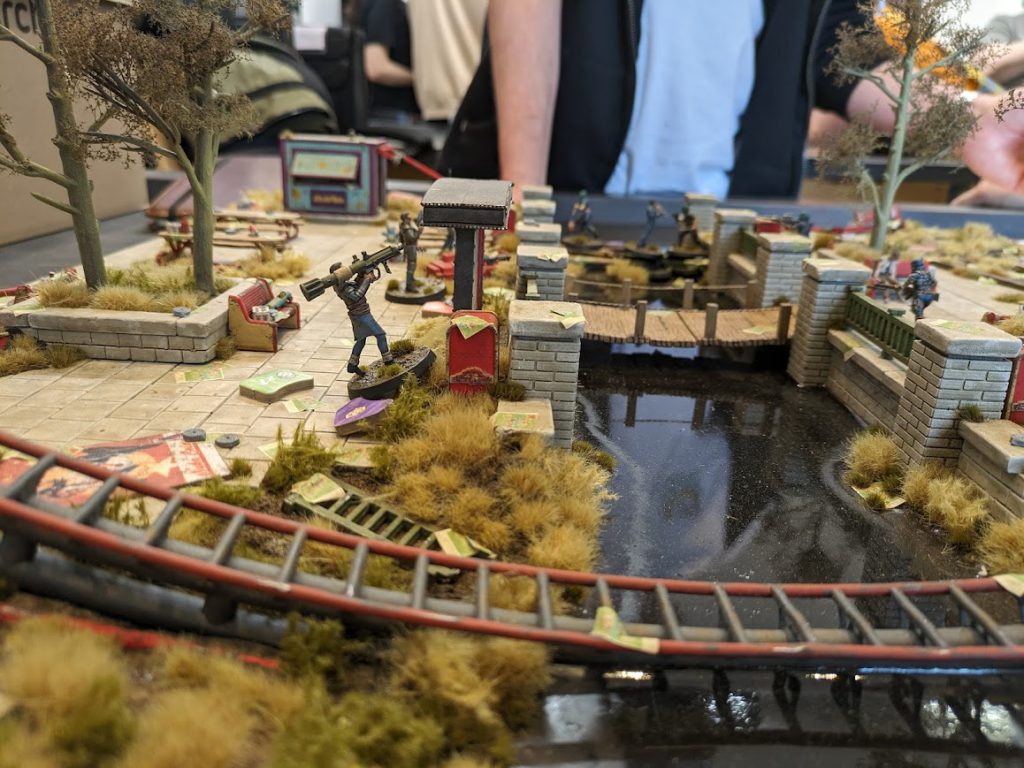
The game I took part in was on this fabulous canal board with bridges running across. There aren’t many terrain rules in the game – just impassable areas (the water was impassable) and elevated areas (that you need to spend movement to climb up the sides of to reach, but can jump off without slowing yourself down). It’s barebones, but combined with the true line of sight rules it makes for fast but thematic gameplay: The terrain matters, but mostly only in terms of actually interacting with each other, not just slowing you down or causing other problems.
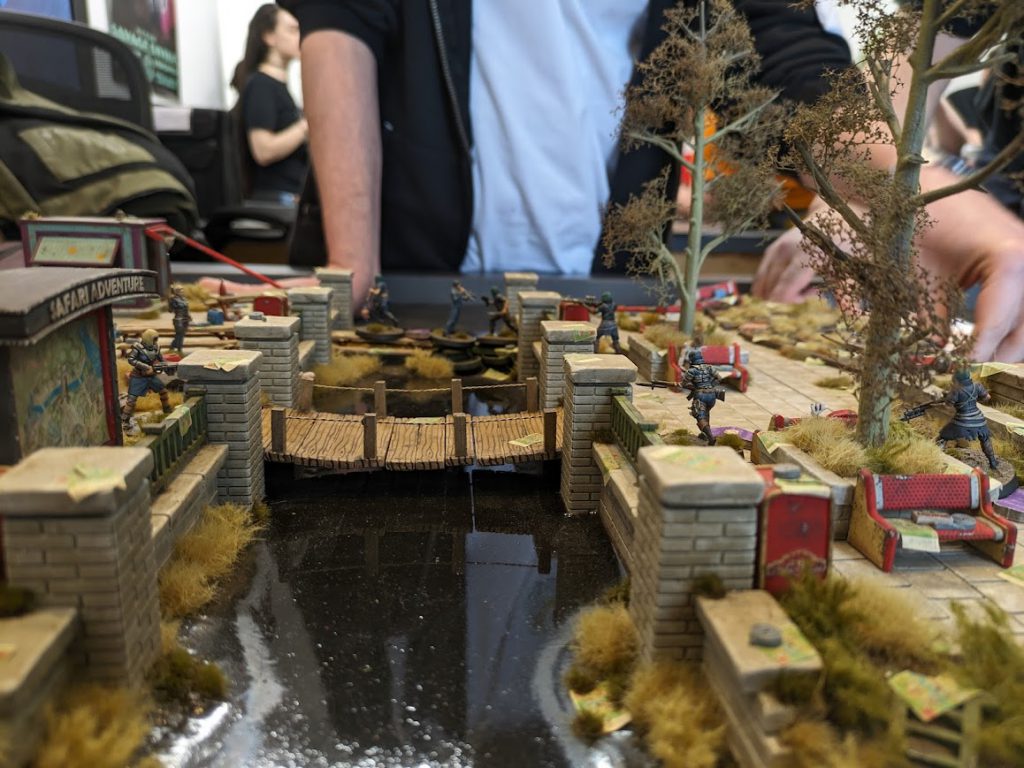
This also highlights of the interesting decision made about how cover works. Instead of having a complex cover system, the rule is simply: If your target is completely out in the open (not blocked by any cover at all), then you get a bonus dice when you shoot at them. Otherwise, you just play as normal. It’s neat and easy without bogging things down, and definitely feels good when you catch people out in the open.
Speaking of dice, let’s have look at how rolls work in the game.
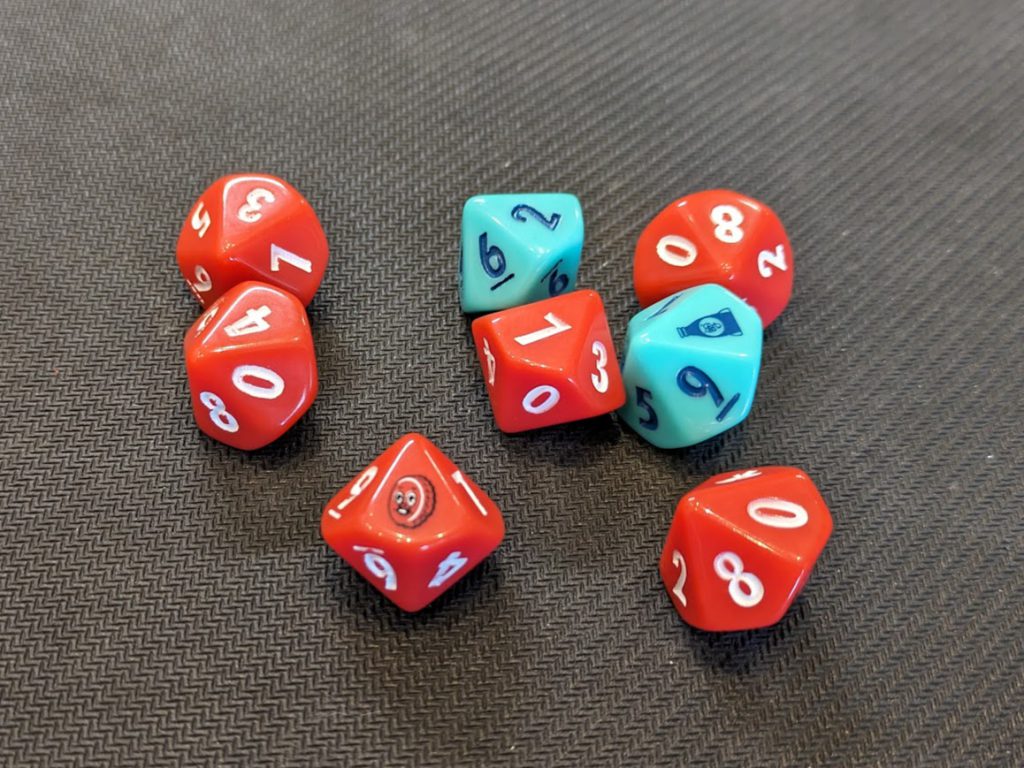
When you attack with a weapon you roll a number of dice depending on the weapon. Bigger and scarier weapons roll more dice. Some of those dice will be “luck dice”, and how many is determined by your luck stat. To get a success, a die has to show equal to or below the relevant stat – so Strength (S) for most melee weapons, Perception (P) for some guns, Agility (A) for others, and so on. When you’re hunting for those low results, if the luck dice show that then the hit is a critical, and you get to apply the critical effect for the weapon, roll an extra die, and add it to the pool.
It’s quick and easy, and I’d say my only critique here is that the ten-sided dice that are used have a 0 as the 10 on the dice, which is the norm but also might be confusing to very new players who are expecting it to count as a low result. I saw it catch a couple of people across the evening.

All of the information you need is on your roster sheet, which for this demo had five models on it, though a full game (played on a 2 foot by 3 foot board rather than the 2 foot by 2 foot demo boards we had) will have about twice as many models. That does mean that the core box contains two complete faction warbands – it’s genuinely a core box that lets you play the full game right away. We’ll come back to the box and what’s in it, but to jump ahead a bit the core box seems like an insanely good offering and starting place.
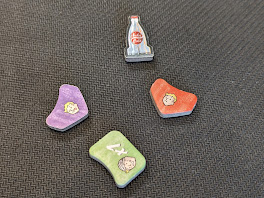
Alongside the dice (which are presented as custom dice with symbols on them, but are in fact just normal d10s, and you can 100% play with any other ten-sided dice you like, as long as you have a different colour to distinguish the luck dice from the rest) there are some nice chunky tokens in the box. These are cardboard, but they feel thick and solid, and there are a good number of each kind, but not an overwhelming variety. Most of them are used to track whether a model has done their action(s) in a round, or to track how much harm they’ve taken (a damage track that can be recovered with in-game actions and which adds bonus dice to enemy rolls against them). It’s pretty easy to track, and the designs are simple but thematic.
The game runs across four game turns and my impression is that this is a staggeringly easy game to learn and teach. If you have a friend who is excited about Fallout but hasn’t dipped their toes into miniature games yet, this is the one to get them in with. There were a huge variety of people playing, from game veterans to cosplayers to painters, and every one of them picked up the game almost instantly. It’s just extremely easy to play. But I was also pleased to see that even in the quick limited games we were playing there were some obvious points of real decision. The action economy and activation system is the star here. As James Hewitt, the designer told me:
“I think that this has got one of the tastiest action economies in a skirmish game. What I mean by that is that if you strip back the theme, the perks, all the nitty-gritty cool stuff that goes on top, the core question you’re asked is how much do you want to do in a turn and what are the consequences of that? It’s a game that lets a player put it all on the line and do something cool, or fail spectacularly.”
That certainly shone through in the demos – my leader with a missile launcher was a real point of chaos in the whole affair, as he threatened such a big area and so there was this real push your luck mechanic with him whenever I was playing: How much do I do right now? How much can I risk leaving him for later? There was a good amount of interesting decision making right away.

Putting it Together
The game seems pretty solid at this point – a very easy entryway into a surprisingly robust and involving experience that should toe the line between being a great intro product but also offering a lot to experienced gamers. That alone make it interesting, but the product offering itself is what will sell it. If the game was overpriced or hard to collect that’s a barrier that no amount of clever rules design can overcoming. Luckily it’s very clear there’s a strong vision about how this game should be presented and sold, and the result is something very special indeed.
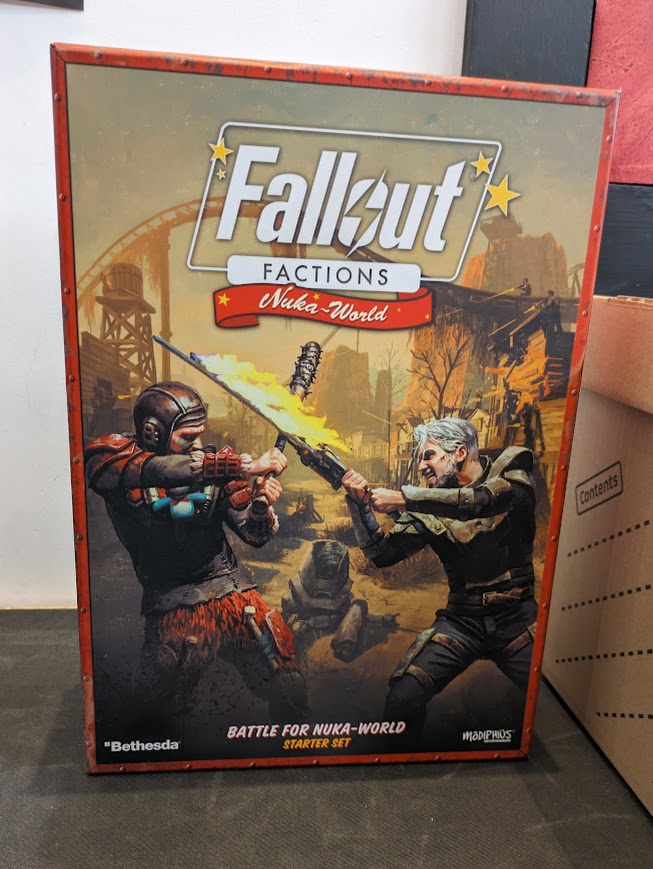
The box is a serious offering for the price point (£85/$110 direct, available at discount from third parties). It contains two full warbands, the Pack and the Operators, and these are genuinely complete warbands – ten minis each on sprues. The miniatures themselves are really nice, lots of detail and multipart plastics are a huge step up over the resin models that Modiphius has relied upon before in their Fallout ranges. This is a sea change, and I really hope they’ll bring other factions (including those with existing models, like the Brotherhood of Steel), to the table in this material. Talking to staff at the event I was told that the ten models each warband have is enough to really pack out a full roster, and while you might expand beyond it sometime in the future it’s absolutely fully optional and something that you’ll only do after a lot of games under your belt, if ever.

As well as dice and tokens, you get a paper battle mat in the box and some terrain. The terrain deserves a special mention here – tough cardstock punchout terrain that looks great and can be popped together and taken apart easily. If you struggle with storage space this is an absolute boon.
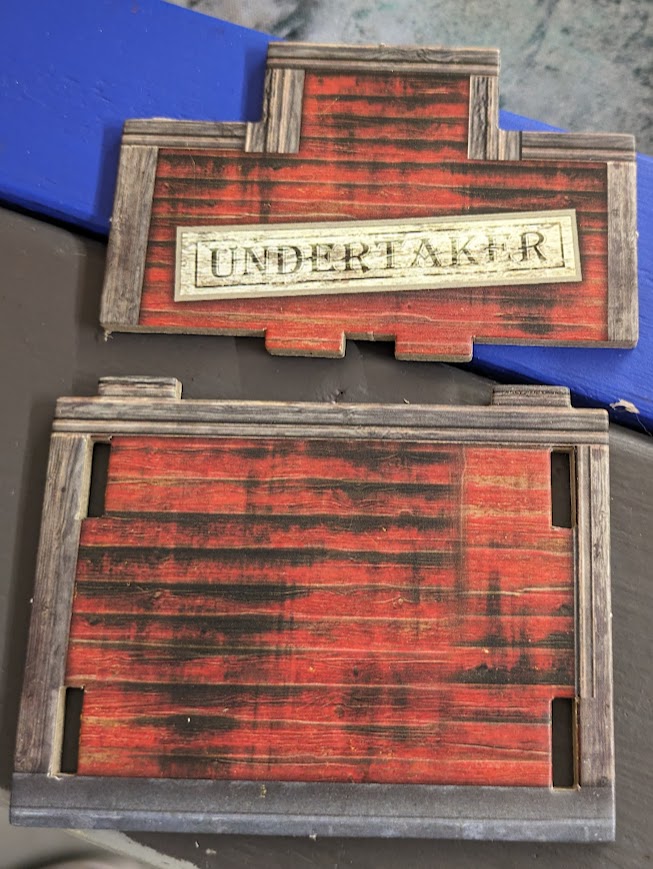
The terrain is just really nice looking and is designed for the “wild west” themed section of the Nuka-World park, which is fun and thematic, and includes these kind of buildings as well as refreshment stands and other elements. But how does this actually look on the table? Well, one great move at the event was that they had a table made using some elements of the card terrain then upgraded and refined with their own STLs and scenic elements.
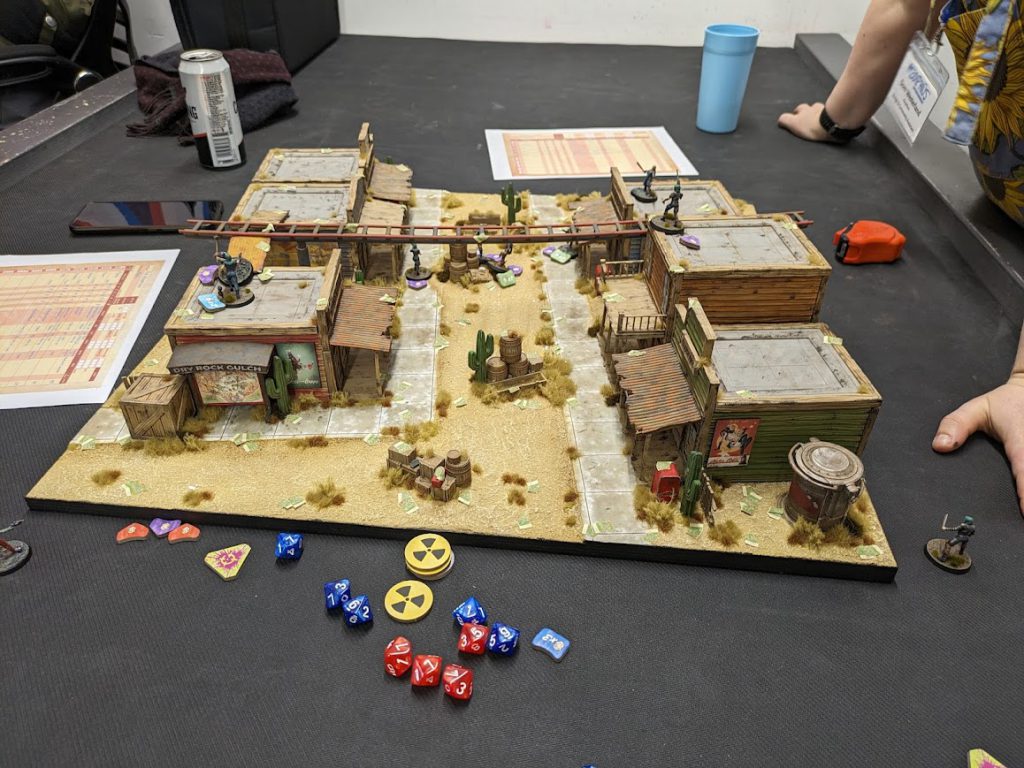
I don’t know about you, but on first glance I really struggled to distinguish which bits are card stock and what else is being used – it’s high enough quality that it all blends in beautifully.
They also showed off a table made of the 3D printed pieces that they also sell STLs for – this is how the other areas of the park will be supported with terrain.
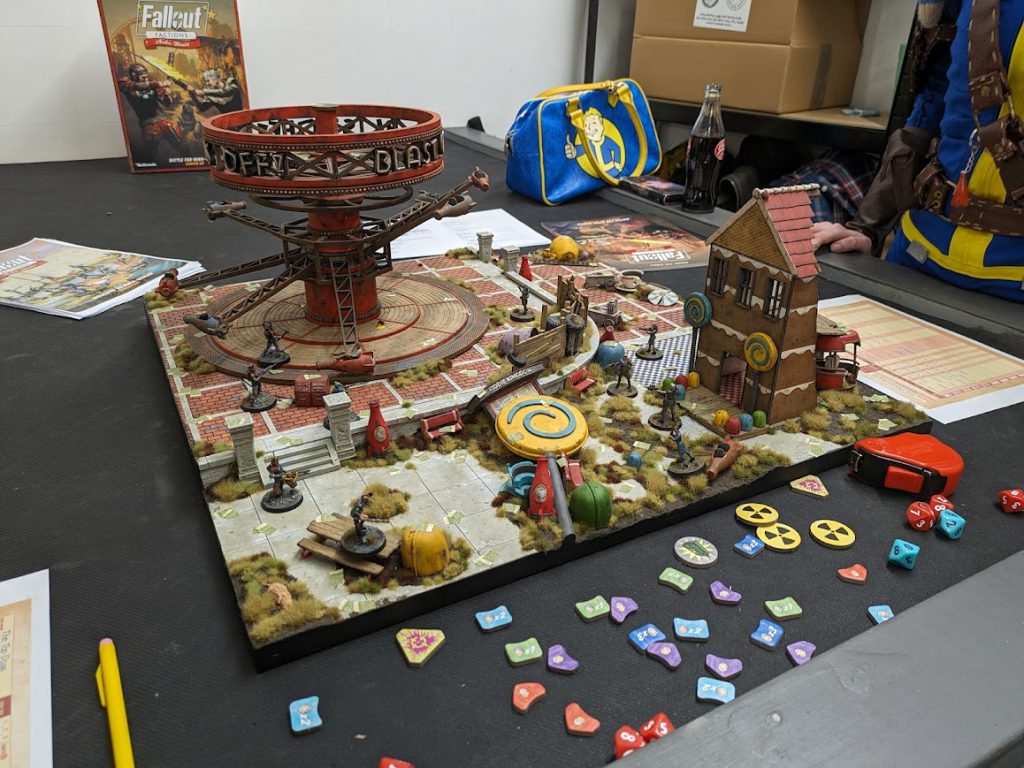
In short this is an incredibly good core box for the price point, and genuinely is a full package. This isn’t a starting point you’ll have to invest a lot more money in to get up to speed, this is a complete game from the moment you crack the lid, including terrain and accessories. It’s maybe the best starter set for a skirmish game I’ve ever seen.
I can whole-heartedly recommend pre-ordering your copy right now.
Next Steps into the Wasteland
I hope you’ve enjoyed this whistlestop tour of the game and the launch event, but don’t worry there’s plenty more content on the way for Fallout Factions. Next week we’ll have a fuller interview with James Hewitt, the designer of the game, who took some time with me at the event to answer a few questions.

After that we’ll start cracking open some of the miniature boxes that were generously gifted to us at the event. We have all three of the launch warbands, and we’ll be reviewing those kits in the coming weeks before launch, as well as showing you how to paint up your own when you pick them up.
Good luck in the Wasteland, wanderers!
Have any questions or feedback? Drop us a note in the comments below or email us at contact@goonhammer.com.
